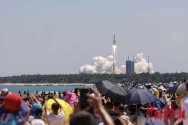Quickie
Colonel
Generally, there is no manual engine cut-off in a test like this. The on-board computer handles everything.
This is how it is supposed to be btw, modern LVs only have manually controlled FTS systems (and some LVs have only automatic FTS too). The job of the modern control center is to monitor, not to command.
Granted, the above is a hypothesis somewhat, since range safety measures in the China are a little opaque (especially when private company testing is concerned).
A static test stand control center does have the ability to cut off the engines any time any anomalies are detected through the sensors. We have seen this happen many times during the testing of new Starship Boosters.


